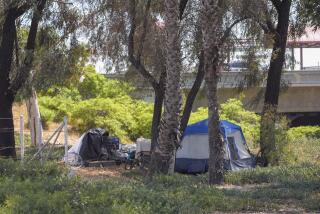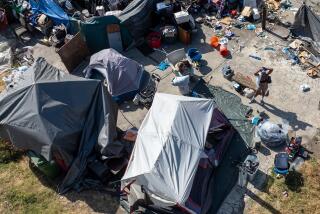A Long Day’s Journey Into Homelessness : Poverty: Being destitute cut a former county athlete down to size--and taught lessons he’d never have otherwise learned.
LAGUNA BEACH — Lonnie Bagley’s 6-foot, 200-pound frame came naturally, without the help of weights or chemicals. It made him a high school hero and a football star in the 1960s, first as a fullback at Fullerton College and later at San Jose State.
But you don’t feel big when you’re homeless, walking the streets. You don’t feel big when you’re hungry and tired, with empty pockets.
“You feel very, very small,” Bagley says now, accenting his point with his thumb and forefinger. “You can measure yourself like this.”
These days, Bagley has resurfaced in his hometown of Laguna Beach, playing guitar at the Fahrenheit 451 bookstore or the Sail Loft or Bagel Heaven, then passing a hat.
At 44, after two years on the streets, Bagley says he is on his way back.
“I’m just glad to be back,” Bagley says, sipping coffee and dragging on a cigarette. “Once somebody has been out on the streets about six months, they usually make a transition, mentally and physically, that makes it difficult to bring them back. I was one of the lucky ones.”
Bagley’s fall was unusual. His family were pioneers who arrived in the county in the mid-1800s and built their lives and communities from the ground up. On his mother’s side, Bagley is a great-grandson of William Spurgeon, patriarch of one of the county’s most prominent families and acknowledged as the founder of Santa Ana in 1869. A Santa Ana street bears the family name.
Bagley grew up in idyllic privilege, first in the safe harbor of Avalon on Santa Catalina Island, where he was born. He spent days diving for coins from tourist boats, wandering the quaint village and watching movies at the casino.
After he spent his first year of high school in San Juan Capistrano, his family moved to Laguna Beach, where he was a popular athlete. He excelled in football, eventually playing for Fullerton in the 1966 Junior Rose Bowl. Later he played for San Jose State.
During those glory days, there was no hint of what was to come much later. Bagley says he quickly bought into the simple ideals of movies and TV.
“The role model idols for me were people like the Lone Ranger, the heroes of old traditional ‘40s and ‘50s movies where the guy leaves with the gal in the sunset,” Bagley says. “My self-esteem was actually built by my own self-picture of who I wanted to be like. I saw myself as a healthy person and achieving person, someone spreading good things.”
Nothing prepared him for two failed marriages and a stumbling career. Neither drugs nor alcohol were his trouble, just those “simple, everyday” problems of divorce, career and self-respect, he says.
In 1983, after nearly 15 years in various restaurant jobs and the Navy, Bagley was in the San Jose area when his second marriage and a career in restaurant management unraveled. He was unprepared.
He had lost a $200,000 home and began to find it hard to look at himself, then hard to make ends meet. Finally, it became hard to find a place to sleep.
“The failure of my second marriage was a very major turning point, . . . (it) was crushing,” Bagley says. “I began reviewing my personal and business abilities. . . . I was, to myself, non-functional.”
Soon he also had very little in the way of assets. “I had no house to go to and no vehicle to drive,” Bagley says. “I could measure myself with this tape ruler.”
He played his guitar in Bay Area clubs to earn bits and pieces of income. For years he tried to keep up an outer facade of relative prosperity, singing for a living, when in reality he was wandering around at night, sleeping in parks.
“I felt completely broken down inside, but I tried not to let it show on the exterior,” he says. “I slept in the best parks I could find, the best areas. . . . I was at Yosemite in my mind, at Half Dome. . . . I constantly rejected a flop shelter, believing that was the last stop before you went to the gutter . . . but there were some times when I couldn’t physically muster enough energy or will.”
He also resisted contacting his family in Laguna Beach because of pride and a determination to get through the rough time himself.
“It was tough on them, but I had my own pride,” Bagley says. “I wanted to pull myself up myself. . . . My family was supportive, but I wanted to do this on my own. I think that is a common feeling among the homeless.”
Bagley says he hit bottom in 1989 when a toothache turned into three agonizing abscessed teeth, and he had a foot infection.
“I was singing in a restaurant and had an actual aspirin wedged in my teeth,” he says. “It was numbing the tooth, or the pain was numbing, but I was singing and smiling. I had to, I needed the money. . . . I also learned a lot about how we have to be actors.”
The toothache and the leg infection nearly killed him but also brought him out the spiral, Bagley says. He literally staggered to a coastal area just south of San Francisco and hid out, the pain nearly making him delirious, until finally it stopped.
“It really gave me a new strength, that experience,” Bagley says. “Somehow it gave me a feeling of power again. I had made an effort, basically because I did not want to die.”
Today, Bagley is staying in Dana Point with a woman he met singing. He returned to Southern California in September, visited his son in the San Diego area, then returned to South County.
In a strict sense, he says, he remains homeless, although he has a roof over his head and has returned to the Laguna Beach area to be near his family.
“In the traditional sense of homelessness, I was without a home for two years,” Bagley says. “But I tend to strike out home and say I was houseless. I always felt like I had a home. My home was me. You are your own home.”
More to Read
Sign up for Essential California
The most important California stories and recommendations in your inbox every morning.
You may occasionally receive promotional content from the Los Angeles Times.






